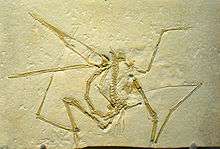Pterodactylidae
Pterodactylidae is a controversial group of pterosaurs. During the 2000s and 2010s, several competing definitions for the various Jurassic pterodactyloid groups were proposed. Pereda-Suberbiola et al. (2012) used Fabien Knoll's (2000) definition of the name Pterodactylidae.[1] Knoll had defined Pterodactylidae as a clade containing "Pterodactylus antiquus, Ctenochasma elegans, their most recent common ancestor and all its descendants".[2] Using this definition with the analysis conducted by Pereda-Suberbiola et al. (2012) meant that Ctenochasmatoidea was nested inside Pterodactylidae.[1]
| Pterodactylids | |
|---|---|
 | |
| Cast of the sub-adult type specimen of Pterodactylus antiquus | |
| Scientific classification | |
| Kingdom: | Animalia |
| Phylum: | Chordata |
| Order: | †Pterosauria |
| Suborder: | †Pterodactyloidea |
| Infraorder: | †Archaeopterodactyloidea |
| Clade: | †Pterodactylidae Bonaparte, 1838 |
| Subgroups | |
Classification
Below is the majority-rule consensus tree found by Pereda-Suberbiola et al. (2012), showing their preferred definitions of Pterodactylidae and Ctenochasmatoidea.[1]
| Pterodactylidae |
| |||||||||||||||||||||||||||||||||||||||||||||
Other researchers, such as David Unwin, have traditionally defined Pterodactylidae in such a way to ensure it is nested within Ctenochasmatoidea instead. In 2003, Unwin defined the same clade (Pterodactylus + Pterodaustro) with the name Euctenochasmatia. Unwin considered this to be a subgroup within Ctenochasmatoidea, but most analyses since have found Pterodactylus to be more primitive than he thought, making Euctenochasmatia the more inclusive group.[3]
References
- Xabier Pereda-Suberbiola; Fabien Knoll; José Ignacio Ruiz-Omeñaca; Julio Company; Fidel Torcida Fernández-Baldor (2012). "Reassessment of Prejanopterus curvirostris, a Basal Pterodactyloid Pterosaur from the Early Cretaceous of Spain". Acta Geologica Sinica. 86 (6): 1389–1401. doi:10.1111/1755-6724.12008. hdl:10651/13364.
- Fabien Knoll (2000). "Pterosaurs from the Lower Cretaceous (?Berriasian) of Anoual, Morocco". Annales de Paléontologie. 86 (3): 157–164. doi:10.1016/S0753-3969(00)80006-3.
- Unwin, D. M., (2003). "On the phylogeny and evolutionary history of pterosaurs", pp. 139–190. in Buffetaut, E. & Mazin, J.-M., (eds.) (2003). Evolution and Palaeobiology of Pterosaurs. Geological Society of London, Special Publications 217.